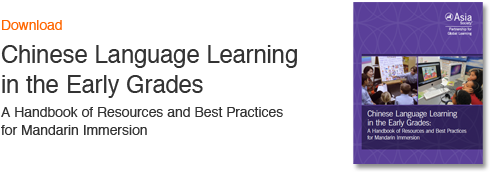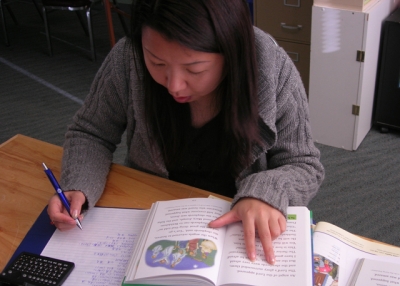Student Assessment and Immersion Program Evaluation

By Ann Tollefson, with Michael Bacon, Kyle Ennis, Carl Falsgraf, and Nancy Rhodes
Student Assessment
Parents enroll their children in language immersion programs in order to give them the gift of knowing another language. They also expect that their children will do as well or better in learning the regular curriculum in the immersion language as will children who are learning that content in English. As a result, there are two fundamental strands of student assessment in elementary immersion programs: assessment of student learning in various subjects taught in the language, (e.g., math and reading); and assessment of the student’s proficiency in the immersion language. Both are used to evaluate individual student progress, to report to parents and the general community, and to support continual program improvement.
Assessment of General Content Learning
The often-repeated mantra of language immersion programs is “first, do no harm.” In other words, children’s grade-level and subject-area learning must not suffer because they are in an immersion program.
In most immersion programs, students take the same summative content-area assessments as children who don’t participate in an immersion program. Formative assessments throughout the year are generally in the immersion language although care is taken to assure that children have the necessary English vocabulary to do well on the district and state summative assessments they will take in English.
Assessments of Student Proficiency in the Immersion Language
Formative Assessments
Formative assessments are used to monitor day-to-day progress in the target language. They also serve as ongoing checks on the effectiveness of the program, informing planning and instruction. They can include:
- Daily quizzes
- Student projects
- Observation checklists of “can do” statements
- Integrated performance assessments
- LinguaFolio self-evaluation
Summative Assessments
There are few summative assessments for children in grades K–6, which means that programs should try to develop a set of measures that will give a well-rounded picture of student proficiency in the immersion language.
In grades K–2, the only national summative assessments of second language acquisition are based on student interviews. These interviews provide rich language data from which to gauge interpersonal listening and speaking skills, as well as interpretive listening skills. For interview-based assessments, schools need to address issues of affordability, staff training, and time needed to assess students. Many K–2 programs use interview-based assessments in conjunction with other measures of student proficiency in the immersion language, including:
- Assessments embedded within instructional units (Integrated Performance Assessments)
- School and district assessments, ideally analyzed within professional learning communities of teachers
- Observation matrixes or checklists of “can do” statements used on an ongoing basis by teachers to track students’ advancement
- Quantitative measures, e.g., number of characters learned by students
For students in grades 3–6, STAMP 4Se is the only online assessment currently available. There are, however, several more assessment tests currently in development.
Since there is currently no single, easy way to assess the proficiency of students in elementary immersion programs, the best approach may be to gather data from several sources, using some data for student assessment and combining it with other data for program evaluation and reporting.
When designing an assessment plan for your students and an evaluation plan for your program, consider the following questions:
- What is your budget for individual student and program assessment?
- What skills are particularly important for your program in case you don’t have the budget to assess every child in every mode and skill? For example, if you had to choose, would you choose to assess listening and speaking or reading and writing? Or is interpersonal communication the most important goal for your program?
- If your budget is limited, can you assess all students in a locally produced assessment (such as an observation checklist of “can do” statements)? Can you use your limited resources to assess a statistically significant number of students on a national assessment in order to pinpoint your program’s strengths and weaknesses?
- How much time are you willing to devote to summative assessments?
- Do you have access to technology that would make online assessment productive?
- How soon do you need to see the results of the assessments?
- What combination of assessments will give you the information you need and still allow you to stay within your budget? (There is no one right answer—you have many options.)
Sample Evaluation Scenarios
You have 250 children in your K–6 Chinese immersion program. Your assessment budget is $2,500, which gives you only $10 per student, well below what most national assessments cost.
Scenario One
You decide to design and use your own teacher-observation checklists for all children in the program. To broaden your program evaluation and provide outside verification of your internal ratings, you decide to assess the top 25 percent of your students on the STAMP 4Se. That will cost approximately $1,550 and it should give you a good idea of your program’s efficacy for students. You can then combine the two measurements into a matrix that you can use to evaluate and plan for the program’s improvement. Those results will also help you report to your community on the program’s progress. The remaining budget can be used to bring together teachers to analyze the results and plan for program improvement. Or you can increase the number of students you assess.
Scenario Two
You follow the same first steps as in Scenario One, but you decide to do a stratified random assessment on the STAMP 4Se of two low-level, two mid-range and two high-performing students from each grade level or class. Selecting students should be done carefully with clear criteria, such as English test scores.
Scenario Three
You decide that you want to develop your internal capacity to assess student proficiency, so you spend your limited resources on training your teachers in administering and using data from the SOPA to evaluate all students in your program. This training is available online. For example, you could train four teachers in designing, administering, and rating the SOPA for $300 each, totaling $1,200 for their joining the Moderated Introduction to SOPA course.
CAL offers an additional course, Rating the SOPA, for $500 per teacher, for additional intensive practice rating at the different proficiency levels. Through these training courses, your staff will have a better understanding of proficiency, which can be the basis for the in-house development of teacher-observation checklists (“can do” statements) for assessing interpretive and presentational skills, which are not assessed by the SOPA.
Scenario Four
As in Scenario Three, you decide to invite four teachers to train for administering and rating for the SOPA, but you reserve some funds to administer the STAMP 4Se to some of your students. With the remaining $1,300, you could assess approximately 65 students, which is slightly over 25 percent of the students in your program.











